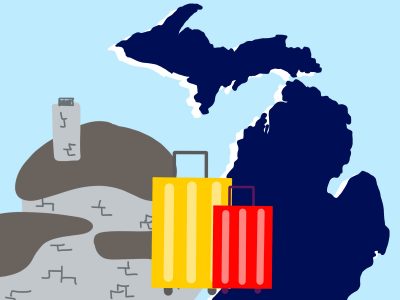I’m on a little bit of a tourist town kick.
As I’ve mentioned before, a lot of small towns in North America have trended toward the same hodgepodge of the most economical developmental styles of the era, and as a result tend to have the same combinations of things to love and hate about them.
I try to find small towns with unique issues, or which offer a unique perspective on cultural norms. As it turns out, most small towns that set themselves apart from others are at least in part tourist destinations. It could be that these cities leverage their one-of-a-kind-ness to attract tourism, or perhaps that tourism itself presents a city with more incentive for unorthodox development, but that’s a column idea for another week.
Today I’m here to share with you the town of Charlevoix (pronounced Shar-Le-Voy), Michigan. It’s a city of about two and a half thousand people on the Northwestern edge of the state, boasting quaint freshwater beaches, lakefront shopping and, most interestingly, a group of remarkable so-called “Mushroom houses” that look like they could be from The Hobbit.
I visited Charlevoix in late August 2020, as a sort of tiny-town escape from coronavirus. The town runs a ferry to Beaver Island — an island even more remote than Charlevoix — which was my ultimate destination.
My first objective in the city was to visit the aforementioned mushroom houses. I made my way across the US. Route 31 lift bridge, which connects the boat owners on Lake Charlevoix to the much larger Lake Michigan.
The collection of homes, built by Earl Young in the early 20th century, and the neighborhood surrounding them, stand out as wholly representative of the Northern Michigan region. Young felt it was important to design his buildings such that they compliment the natural surroundings, and he consequently combined sheltered entrances with cobblestone walls for an architectural style that fits charmingly in the wooded lakefront of Charlevoix.

The neighborhood along Park Avenue — named “Boulder Park” by Young — is clustered with similar houses utilizing the natural area as inspiration for the home’s curved driveways and cobblestone finishings. As an added bonus of Charlevoix’s smaller size, these original mushroom houses are a mere seven minute walk from the downtown shopping center.
With exceptions for the oldest parts of some larger East Coast cities, and Southwest mission towns, architectural styles in North America feel especially homogenized. It’s why we have the concept of Anytown, USA. There is an assumption made about North American small towns that they all have the same overall look and feel, and for the most part, this assumption is not far off.
These suburbanites, who make up over half the United States population, like to visit tourist towns because they offer something new. Unique architecture and walkable downtowns please the eye of the Anytown resident. We visit Tokyo and Paris and Boston’s North End because these places hold an artistic novelty in their historical developmental styles.
The works of Charlevoix’s Earl Young demonstrate that we shouldn’t have to travel around the world to find building styles that set themselves apart from the uninspired suburb.
Imagine a U.S. where each state, or even each geographic region, created its own form of “mushroom house” style to be proud of. In a country where we value individuality to a fault, why have we settled for living in the same cookie-cutter houses as everyone else?



















































































































